Nico Angiuli’s latest project is an experimental film – developed through periods of residency and workshops – which wants to trigger a reflection on the theme of humanization of machines analysing the dehumanization of the human being. We are talking about ‘The human tool and the community of parahuman machines’, (please see our previous article), the artistic proposal by Cittadellarte which has won the Italian Council Award, an initiative launched by DGAAP (the Ministry of Cultural Heritage’s General Directorate of Contemporary Art and Architecture and Suburban Areas). In the context of this initiative, the spaces of Fondazione Pistoletto have hosted workshops that have seen the participation of international guests from the worlds of robotic and artificial intelligence, work sociology and investigative journalism. Speakers at the group discussions held so far have been Rosario Sorbello (co-director of Roboticslab – the department of industrial and digital innovation of the University of Palermo), Albert Nikolla (executive director at Coherent Development Albania, Tirana) and Jean-René Bilongo (migration manager for Flai-Cgil).
The workshop with Rosario Sorbello
Nico Angiuli has talked to us about the contents emerged from the workshops: “We have had the opportunity to invite and have as our guests three important figures from our field of research. The first workshop was held on 29th October by IT engineer Rosario Sorbello, who presented to us his Telenoid. It is an evolved machine able to communicate with human beings through a system of facial recognition and to physically respond to the emotions of people surrounding it. In some respects, it can even temporarily replace the actual presence of workers or parents. It’s a sort of 3D Skype”. The participants in the activity – Angiuli, Cittadellarte’s staff and a few actors from the film – were struck by the way the Telenoid could replicate the human being with its machine-like presence.
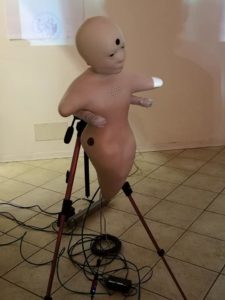

And this is exactly the central theme of the artist’s research, i.e. the study of the development of these parallel forms of life. “They are copies of man – continues Angiuli – which aspire to assume a role and a social space. Human beings are trying to accommodate them in their daily lives, since these parahuman forms will soon be able to relate with men”. According to the artist, the humanization of non-human forms is not a novelty of our times: “If we consider the subject of amazing and self-moving machines, – he argues – we can already find two key references in ancient Greek methodology: Daedalus and Aristofanes. Mentioned in mythology as craftsmen and demiurges, they were capable of ‘giving life’ to their sculptures. We can therefore see that even if the desire to animate inanimate forms has been accomplished only today with the creation of androids fitted with artificial intelligence, it was in fact born a long time ago; this bridge between past and future is another line we are following in developing our work”.
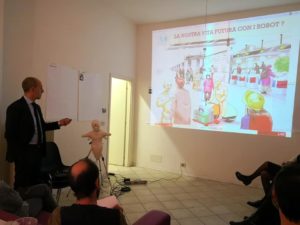
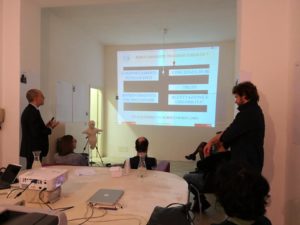
The workshop with Albert Nikolla
The second guest was Albert Nikolla: “With the historian, – says Nico Angiuli – we reasoned about another tension which, both ideologically and politically, has wanted to transform the human being into a sort of exemplary political model. We considered the new man (as the researcher himself, the Marxist manifesto and Lenin have defined it) identifying it as a figure also able to annihilate family values. In this regard, Albert explained how the theme of the lie was somehow endemic of the old Albanian society. The public charade of survival was in fact resting on it: people acted and spoke in line with the precepts of the party and of the stereotype, lying about their actual thoughts and intentions. We can therefore say that this is another instance of a political tension aiming at building a subject and moulding the human figure through an ideological model”.
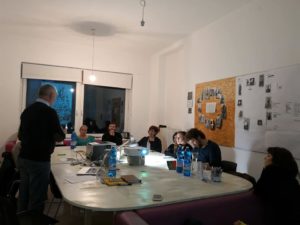

The workshop with Jean-René Bilongo
The third guest at the workshops in Cittadellarte was Jean-René Bilongo, who took the participants through a reflection on the present status of work in Italy analysing the body as an element of struggle and contention. “Jean-René Bilongo – states Angiuli – examined the factor of the body, on which – especially in the case of heavy manual jobs – all the complexities of an economical work model in crisis are unloaded: an underpaid, exploited, often violated and annihilated body. Jean-René Bilongo explained how this model of abuse of the body is an expression of the Italian structural system, almost as if the ‘made in Italy’ was based on this prerogative”.
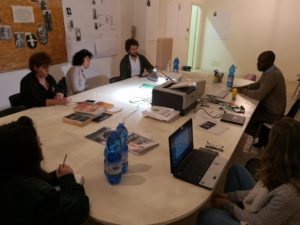

The next steps and the actors
Angiuli’s work group is at the moment elaborating the contents of the three meetings in order to present them in the form of a drama. As mentioned, some members of the cast took part in the workshops, as a way for them to get to know the subject of the work through the stories and the experiences of the lecturers, making it easier for them to identify with their characters. The opportunity to collaborate in the understanding of the themes of the film will allow the whole group to contribute in co-building the narrative. “We profile the characters who will act out what has emerged from our sessions, – specifies the artist – a profiling which will then be defined and intertwined through the dialogues between the characters; this is the key moment producing reflections and creative outcomes. We have cast both professional actors and ordinary people without any prerogatives in the field, thus assembling a pool of performers who have a lot in common with the characters we are building and they will interpret. It is a way of working disconnected from the practice of the traditional cinematographic industry and which follows instead a principle that I define of adherence between character and interpreter”. The sessions have not come to an end: the artist has planned new workshops with speakers whose identity will be revealed in the next few weeks.

